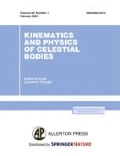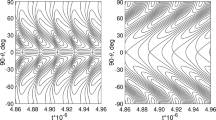Abstract—
The article shows the dominant role of the global migratory flow (GMF) \({{v}_{{gmf}}} = \left\{ {v_{{gmf}}^{R},v_{{gmf}}^{\theta },v_{{gmf}}^{\varphi }} \right\}\) in the generation of the variable magnetic field of the Sun (\(v_{{gmf}}^{R}\), \(v_{{gmf}}^{\theta }\), and \(v_{{gmf}}^{\varphi }\) are the radial, meridional, and latitudinal GMF velocity components, which correspond to the velocities of the radial flow variation, spatial and temporal variation of the meridional flow, and torsional oscillations). A magnetic vector \(H^{*} = \left\{ {{{H}_{\theta }},{{H}_{\varphi }}} \right\}\), which is called a model bipolar group of spots (\({{H}_{\theta }}\) and \({{H}_{\varphi }}\) are the meridional and azimuthal components of the variable magnetic field of the Sun), is introduced. As a result of the performed numerical calculations and on the basis of the kinematic dynamo model, a scheme of the latitude–time distribution of relative amplitudes of magnetic components \({{H}_{\theta }}\) and \({{H}_{\varphi }}\) on the surface of the Sun during the 22-year magnetic cycle are constructed. It is found that the relative amplitudes of the meridional and azimuthal variable fields depend on heliolatitude. They have maximum values in the near-equatorial belt and decrease to minimum values in near-polar belts. In the near-equatorial belt, the magnetic sign of the head spot of the model bipolar group of spots coincides with the sign of the radial field in the near-polar belt. This corresponds to the ratio of the observed signs of the bipolar groups of spots and the near-polar field in the Hale magnetic cycle. At the same time, the signs of bipolar groups of spots at high heliolatitudes are in conflict with the Hale–Nicholson law. Obviously, the violation of the polarities of the vector \(H{\kern 1pt}^{*}\) can be explained by taking into account the results of simulating the dependence of the constant toroidal magnetic field on the polar angle that we obtained in previous studies. At the same time, the deviation from the Hale–Nicholson law can apparently be related to the polarity of the first high-latitude bipolar groups of spots of the new cycle observed at the end of old cycles.






Similar content being viewed by others
REFERENCES
A. G. Zagorodnii and O. K. Cheremnykh, Introduction to Plasma Physics (Naukova Dumka, Kyiv, 2014) [in Russian].
I. O. Kremenets’kii and O. K. Cheremnykh, Space Weather: Mechanisms and Manifestations (Naukova Dumka, Kyiv, 2009) [in Ukrainian].
A. A. Loginov, V. N. Krivodubskii, O. K. Cheremnykh, and N. N. Sal’nikov, “On spatial-temporal structure of the Sun global flow,” Visn. Kiiv. Nats. Univ. im. T. Shevchenka, Astron. 48, 54–57 (2012).
A. A. Loginov, N. N. Sal’nikov, O. K. Cheremnykh, V. N. Krivodubskii, and N. V. Maslova, “Hydrodynamic model for generation of global poloidal flow of the Sun,” Kosm. Nauka Tekhnol. 17 (1), 29–35 (2011).
A. A. Loginov, Yu. I. Samoilenko, and V. A. Tkachenko, “Excitation of a meridional flow by differential rotation in the Earth’s liquid core,” Kosm. Nauka Tekhnol. 6 (2–3), 53–68 (2000).
A. A. Loginov, O. K. Cheremnykh, V. N. Krivodubskii, and N. N. Sal’nikov, “Hydrodynamic model of torsion oscillations of the Sun,” Kosm. Nauka Tekhnol. 18 (1), 74–81 (2012).
Yu. I. Samoilenko, Problems and Methods of Physical Cybernetics (Inst. Mat. Nats. Akad. Nauk Ukr., Kyiv, 2006), in Ser.: Proceedings of the Institute of Mathematics of the National Academy of Sciences of Ukraine, Vol. 56.
Yu. I. Samoilenko, A. A. Loginov, and V. A. Tkachenko, “Modeling the generation of the geomagnetic field,” Vestn. Kherson. Gos. Tekh. Univ., No. 3 (12), 235–244 (2001).
A. I. Khlystova and D. D. Sokolov, “Toroidal magnetic field of the Sun from data on Hale-rule-violating sunspot groups,” in Solar and Solar-Terrestrial Physics — 2008 (Gl. Astron. Obs. Ross. Akad. Nauk, St. Petersburg, 2008), pp. 373–374 [in Russian].
R. C. Altrock, “An "extended solar cycle” as observed in Fe XIV,” Sol. Phys. 170, 411–423 (1997).
H. D. Babcock, “The Sun’s polar magnetic field,” Astrophys. J. 130, 364–365 (1959).
H. W. Babcosk, “The topology of the Sun’s magnetic field and the 22 year cycle,” Astrophys. J. 133, 572–1033 (1961).
P. Charbonneau, “Dynamo models of the solar cycle,” Living Rev. Sol. Phys. 7 (3), 1–91 (2010).
G. E. Hale, F. Ellerman, S. B. Nicholson, and A. H. Joy, “The magnetic polarity of sun-spots,” Astrophys. J. 49, 153–186 (1919).
G. E. Hale and S. B. Nicholson, “The low of Sun-spot polarity,” Astrophys. J. 62, 270–300 (1925).
G. E. Hale and S. B. Nicolson, Magnetic Observations of Sunspots, 1917–1924, Carnegie Institute Publication No. 438 (Carnegie Inst. of Washington, Washington, DC, 1938), Part 1.
R. Howe, J. Christensen-Dalsgaard, F. Hill, R. W. Komm, R. M. Larsen, J. Schou, M. J. Thompson, and J. Toomre, “Dynamic variations at the base of the solar convection zone,” Science 287, 2456–2460 (2000).
V. N. Krivodubskij, “Turbulent dynamo near tachocline and reconstruction of azimuthal magnetic field in the solar convection zone,” Astron. Nachr. 326, 61–74 (2005).
V. N. Krivodubskij, “Double maxima of 11-year solar cycles,” Kinematics Phys. Celestial Bodies 33, 24–38 (2017).
V. N. Kryvodubs’kyj, “Dynamo parameters of the solar convection zone,” Kinematics Phys. Celestial Bodies 22, 1–20 (2006).
A. G. Kosovichev and V. V. Pipin, “On the origin of solar torsional oscillations and extended solar cycle,” Astrophys. J. 887, 215–231 (2019).
A. A. Loginov, O. K. Cheremnykh, V. N. Krivodubskij, and N. N. Salnikov, “Hydrodynamic model of spatial and temporial variations of poloidal and toroidal components of three-dimensional solar flows,” Bull. Crimean Astrophys. Observatory 108, 58–63 (2012).
A. A. Loginov, V. N. Krivodubskij, and O. K. Cheremnykh, “Generation of the Sun’s radial magnetic field by global hydrodynamic flows,” Kinematics Phys. Celestial Bodies 36, 56–63 (2020).
A. A. Loginov, V. N. Krivodubskij, N. N. Salnikov, and Yu. V. Prutsko, “Simulating the generation of the solar toroidal magnetic field by differential rotation,” Kinematics Phys. Celestial Bodies 33, 265–275 (2017).
A. A. Loginov, N. N. Salnikov, O. K. Cheremnykh, Ya. I. Zyelyk, and N. V. Maslova, “On the hydrodynamic mechanism of the generation of the global poloidal flux on the Sun,” Kinematics Phys. Celestial Bodies 27, 217–223 (2011).
M. Ossendrijver, “The solar dynamo,” Astron. Astrophys. Rev. 11, 287–367 (2003).
E. N. Parker, “The formation of sunspots from the solar toroidal field,” Astrophys. J. 121, 491–507 (1955).
E. R. Priest, Solar Magnetohydrodynamics (Reidel, Dordrecht, 1981).
J. O. Stenflo, “Comments on the concept of an “extended solar cycle”,” in The Solar Cycle, Ed. by K. L. Harvey (Astronomical Society of the Pacific, San Francisco, Cal., 1992), in Ser.: ASP Conference Series, Vol. 27, pp. 421–424.
P. R. Wilson, R. C. Altrocki, K. L. Harvey, S. F. Martin, and H. B. Snodgrass, “The extended solar activity cycle,” Nature 333, 748–750 (1988).
Ya. B. Zeldovich, A. A. Ruzmaikin, and D. D. Sokoloff, Magnetic Fields in Astrophysics (Gordon and Breach, New York, 1983).
Funding
The work of A.A. Loginov and O.K. Cheremnykh was supported in part by the Target Complex Program of the National Academy of Sciences of Ukraine in Plasma Physics. The work of V.N. Krivodubskij was supported under the state budget theme no. 19BF023-03 of Taras Shevchenko National University of Kyiv.
Author information
Authors and Affiliations
Corresponding authors
Additional information
Translated by O. Pismenov
About this article
Cite this article
Loginov, A.A., Krivodubskij, V.N. & Cheremnykh, O.K. Generation of the Solar Variable Magnetic Field by the Global Migratory Flow. Kinemat. Phys. Celest. Bodies 37, 16–26 (2021). https://doi.org/10.3103/S0884591321010037
Received:
Revised:
Accepted:
Published:
Issue Date:
DOI: https://doi.org/10.3103/S0884591321010037



